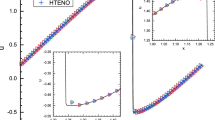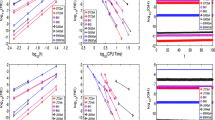Abstract
In this paper, we present a class of finite volume trigonometric weighted essentially non-oscillatory (TWENO) schemes and use them as limiters for Runge-Kutta discontinuous Galerkin (RKDG) methods based on trigonometric polynomial spaces to solve hyperbolic conservation laws and highly oscillatory problems. As usual, the goal is to obtain a robust and high order limiting procedure for such a RKDG method to simultaneously achieve uniformly high order accuracy in smooth regions and sharp, non-oscillatory shock transitions. The major advantage of schemes which are based on trigonometric polynomial spaces is that they can simulate the wave-like and highly oscillatory cases better than the ones based on algebraic polynomial spaces. We provide numerical results in one and two dimensions to illustrate the behavior of these procedures in such cases. Even though we do not utilize optimal parameters for the trigonometric polynomial spaces, we do observe that the numerical results obtained by the schemes based on such spaces are better than or similar to those based on algebraic polynomial spaces.
































Similar content being viewed by others
References
Biswas, R., Devine, K.D., Flaherty, J.: Parallel, adaptive finite element methods for conservation laws. Appl. Numer. Math. 14, 255–283 (1994)
Burbeau, A., Sagaut, P., Bruneau, C.H.: A problem-independent limiter for high-order Runge-Kutta discontinuous Galerkin methods. J. Comput. Phys. 169, 111–150 (2001)
Christofi, S.: The study of building blocks for essentially non-oscillatory (ENO) schemes. Ph.D. thesis, Division of Applied Mathematics, Brown University (1996)
Cockburn, B., Hou, S., Shu, C.W.: The Runge-Kutta local projection discontinuous Galerkin finite element method for conservation laws IV: the multidimensional case. Math. Comput. 54, 545–581 (1990)
Cockburn, B., Lin, S.Y., Shu, C.W.: TVB Runge-Kutta local projection discontinuous Galerkin finite element method for conservation laws III: one dimensional systems. J. Comput. Phys. 84, 90–113 (1989)
Cockburn, B., Shu, C.W.: The Runge-Kutta local projection P1-discontinuous Galerkin finite element method for scalar conservation laws. Modél. Math. Anal. Numér. 2AN(25), 337–361 (1991)
Cockburn, B., Shu, C.W.: TVB Runge-Kutta local projection discontinuous Galerkin finite element method for conservation laws II: general framework. Math. Comput. 52, 411–435 (1989)
Cockburn, B., Shu, C.W.: The Runge-Kutta discontinuous Galerkin method for conservation laws V: multidimensional systems. J. Comput. Phys. 141, 199–224 (1998)
Harten, A.: High resolution schemes for hyperbolic conservation laws. J. Comput. Phys. 49, 357–393 (1983)
Harten, A., Osher, S.: Uniformly high-order accurate non-oscillatory schemes. IMRC Technical Summary Report 2823, Univ. of Wisconsin, Madison, WI (1985)
Jiang, G.S., Shu, C.W.: Efficient implementation of weighted ENO schemes. J. Comput. Phys. 126, 202–228 (1996)
Liu, X.D., Osher, S., Chan, T.: Weighted essentially non-oscillatory schemes. J. Comput. Phys. 115, 200–212 (1994)
Qiu, J., Shu, C.W.: Hermite WENO schemes and their application as limiters for Runge-Kutta discontinuous Galerkin method: one dimensional case. J. Comput. Phys. 193, 115–135 (2004)
Qiu, J., Shu, C.W.: Runge-Kutta discontinuous Galerkin method using WENO limiters. SIAM J. Sci. Comput. 26, 907–929 (2005)
Qiu, J., Shu, C.W.: Hermite WENO schemes and their application as limiters for Runge-Kutta discontinuous Galerkin method II: two-dimensional case. Comput. Fluids 34, 642–663 (2005)
Reed, W.H., Hill, T.R.: Triangular mesh methods for neutron transport equation. Tech. Report LA-UR-73-479, Los Alamos Scientific Laboratory (1973)
Shi, J., Hu, C., Shu, C.W.: A technique of treating negative weights in WENO schemes. J. Comput. Phys. 175, 108–127 (2002)
Shu, C.W.: Essentially non-oscillatory and weighted essentially non-oscillatory schemes for hyperbolic conservation laws. ICASE Report 97-65
Shu, C.W.: TVB uniformly high-order schemes for conservation laws. Math. Comput. 49, 105–121 (1987)
Shu, C.W., Osher, S.: Efficient implementation of essentially non-oscillatory shock capturing schemes. J. Comput. Phys. 77, 439–471 (1988)
Yuan, L., Shu, C.W.: Discontinuous Galerkin method based on non-polynomial approximation spaces. J. Comput. Phys. 218, 295–323 (2006)
Yuan, L., Shu, C.W.: Discontinuous Galerkin method for a class of elliptic multi-scale problems. Int. J. Numer. Methods Fluids 56, 1017–1032 (2008)
Zhu, J., Qiu, J.: A class of the fourth order finite volume Hermite weighted essentially non-oscillatory schemes. Sci. China Ser. A 51, 1549–1560 (2008)
Zhu, J., Qiu, J.: Hermite WENO schemes and their application as limiters for Runge-Kutta discontinuous Galerkin method III: unstructured meshes. J. Sci. Comput. 39, 293–321 (2009)
Zhu, J., Qiu, J.: Trigonometric WENO schemes for hyperbolic conservation laws and highly oscillatory problems. Commun. Comput. Phys. 8, 1242–1263 (2010)
Zhu, J., Qiu, J., Shu, C.W., Dumbser, M.: Runge-Kutta discontinuous Galerkin method using WENO limiters II: unstructured meshes. J. Comput. Phys. 227, 4330–4353 (2008)
Author information
Authors and Affiliations
Corresponding author
Additional information
The research was partially supported by NSFC grant No. 10931004, 11002071 and ISTCP of China Grant No. 2010DFR00700.
Rights and permissions
About this article
Cite this article
Zhu, J., Qiu, J. WENO Schemes and Their Application as Limiters for RKDG Methods Based on Trigonometric Approximation Spaces. J Sci Comput 55, 606–644 (2013). https://doi.org/10.1007/s10915-012-9649-9
Received:
Revised:
Accepted:
Published:
Issue Date:
DOI: https://doi.org/10.1007/s10915-012-9649-9





